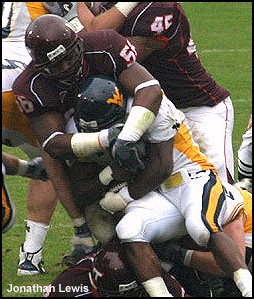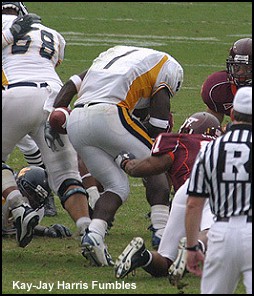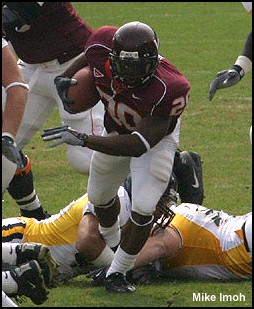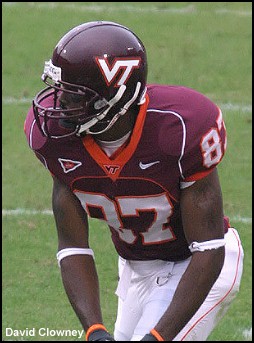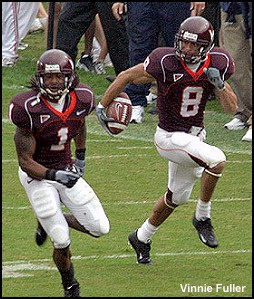|
by Will Stewart, TechSideline.com, 10/5/04 Note: the defensive player of the game will be posted later (I'm betting it's Vinnie Fuller!)
This game analysis won't be quite so intensive as the last one (primarily because the last one darn near killed me). When the Hokies lose, I search for answers in the details, and when they win, I tend to paint with a broad brush. I'll throw a few stats at you, but for the most part, we'll take a look at the larger trends that settled this game. Speaking of large things, let's start with Tech's defensive play, particularly that of Jonathan Lewis.
One of the things I loved about former Hokie defensive tackle David Pugh (1998-2001) was the way Pugh would make a statement early in the game. The opposing offense would line up for their first series, and Pugh would bust up the middle and take down a running back, or flush the opposing QB out of the pocket and into the arms of a waiting defensive end. Pugh loved an early how-do-you-do play to set the tone. Jonathan Lewis, shown swallowing a WVU running back whole in the intro picture above, had such a game on Saturday against WVU, including the introductions on WVU's first possession. After WVU backed themselves up on first down with an illegal block, Lewis tackled Rasheed Marshall on a QB draw that gained 3 yards (though it was James Griffin who came up and rocked Marshall with the first hit). On 2nd and 16, Marshall handed off to Kay-Jay Harris. It is the exact kind of play that WVU has killed the Hokies with the last two years: Marshall hands off to the running back, who gets to survey the line, get a good running start, and pick his hole on his way to a 5-8 yard gain, or more. Except this time, Lewis blew it up, pushing his blocker back into the backfield and forcing Harris to break the run outside. James Anderson was waiting for Harris there, and Lewis pursued like a demon, sloughing off his blocker and running Harris down from behind as he tried to put a move on Anderson. No gain, setting up 3rd and 16, one of 13 third-downs WVU wouldn't convert. For the day, Lewis had 7 tackles, including one and a half for loss and two more for no gain (DL coach Charley Wiles said he had three tackles for loss on Beamerball.com; the hokiesports.com box score says 1.5). He was a demon on short yardage, where he had a hand in stopping three 3rd-and-short and 4th-and-short situations, either by making the tackle himself or stonewalling the line of scrimmage so a linebacker could make the tackle. Lewis and James Anderson combined for two stops where Lewis disrupted the play and Anderson feasted on the leftovers. Lewis was strong all day long. Wiles called it his best game since arriving at Virginia Tech, and that's not hyperbole. I've said it before and I'll say it again: the light usually goes on for a player in his third year in the program, and this is Lewis' third year at VT. He has made great plays at times – for instance, last year he had 7 TFL's and 4 sacks, decent totals for a DT – but he has not been able to bring the heat consistently throughout a ball game, and many times he hasn't even been able to string together three good plays. In the last two weeks, Lewis has shown more push through the line and more pursuit down the line than he has in his first two seasons. He's not alone among the defensive tackles. Converted DE Jim Davis accomplishes pressure through a combination of speed and strength. He only had one tackle in this game, but he was very active. Carlton Powell knocked Kay-Jay Harris out of this game with a first-quarter tackle for a 1-yard loss, then he finished him off on the opening play of the second quarter when he burst up the middle and tackled him for a 3-yard loss. The defensive line in general continued their strong play. After Vinnie Burns shanked a horrible 11-yard punt on his first kick, spotting the ball at the WVU 37-yard line, Darryl Tapp (5 tackles, 1 TFL) made an athletic stop on wideout Ed Jackson on an end-around, throwing him for a 9-yard loss and turning the momentum back to VT. It's the kind of play that Tapp might have lost containment on last year, when he was active but less disciplined. In all, the Hokie DL had 5 of Tech's 7 tackles for loss, and on the season, the DL has 24.5 of Tech's 37 tackles for loss (66%). Last season, they had 49 of 99 TFLs (50%). They averaged 3.77 TFLs per game last year in 13 games, and this year, they're averaging 4.9. And in the stat I'm watching the most this year, Tapp is still second on the team in total tackles with 28 (Vince Hall leads with 30, and Vinnie Fuller is third with 25). Remember, no defensive end has finished higher than #3 on the team in tackles since Jimmy Whitten in 1990. The point is, the difference in this game, and perhaps this season, for the defense has been the play of the defensive line, particularly the tackles. The Hokies are getting a good push with the line, and the tackles, led by Lewis, really disrupted the WVU rushing game. With the spread offense WVU runs, if you don't get a push with the DL and you allow their running backs and QB to get a good look at the holes, you're in big trouble. That's what happened the last two years, but it didn't happen this year, and that was the difference in this game. After giving up 263 and 264 yards rushing in 2002 and 2003, VT gave up just 134 yards on 36 carries in this game, and 46 of that came on one play, the touchdown run by Marshall in the fourth quarter. Outside of that, WVU only averaged 2.5 yards per carry, after averaging 5.0 yards per carry against VT in 2002 and 2003.
Stopping the run sets up everything else for the defense. To dig a little deeper, stopping a team on first down, the majority of which are runs, sets everything else up. WVU ran 15 times on first down and passed 8 times, and they averaged a mere 3 yards on first down. That set the table for a lot of 2nd and long and 3rd and long situations, which are relatively easy to defend. "Long" is defined as 7 yards or more to go for a first down, and WVU faced the following:
I notice two things: (1) WVU got no 3rd and short or 4th and short situations in the entire second half, and (2) WVU bullheadedly went up the middle on every short-yardage situation on 3rd and 4th down. Defensively, the Hokie plan was to stop the run and make Rasheed Marshall beat them with the pass. WVU played right into it by trying to play power football on short-yardage downs, and by running 65% of the time on first down. VT stacked the line on short yardage, and WVU stubbornly went right at it, only to fail. You might wonder if WVU's penalties contributed to their lack of short-yardage situations. After reviewing all of their penalties, I can report that not once did WVU turn a short-yardage situation into long-yardage because of a penalty. They did wipe out their one 3rd-down conversion with a penalty, though. (Statistical oddity: of the 25 penalties in the game, only 7 came when WVU was on offense.) One statistic of note going into the game was that WVU's leading receiver was Chris Henry (23 catches in 4 games), and their second-leading receiver was the backup tailback, Colson (6 receptions – that's right, 6). WVU was very much a one-trick pony in the passing game, and their weakness showed up against VT. Henry had 5 catches, but his longest reception was only 12 yards, and as Raleigh Hokie pointed out in his post-game follow-up, Henry appeared "disinterested," not putting forth much effort. Jack Bogaczyk wrote in the Charleston Daily Mail on Monday:
Bud Foster's game plan was sound, and WVU coach Rich Rodriguez, knowing his team's strengths (power running) and weaknesses (passing), played right into it. The only time the Hokies ran into trouble, as far as I could tell, came when the backups were in the game on defense. WVU put together a 4-play, 76-yard drive to make it 19-13 in the fourth quarter, and it came against the backup DL, plus whip linebacker Aaron Rouse. On Marshall's 46-yard run, DE Chris Ellis pinched down and failed to keep containment, and the tailback blocked Rouse out of the play, opening up the running lanes for Marshall. Marshall juked Fuller and ran by Eric Green on his way to paydirt. It was the exact kind of play that Jonathan Lewis, Darryl Tapp, and James Anderson had been squelching all day long, but WVU sprung it that one time on the backups. One week after roasting offensive coordinator Bryan Stinespring, I will sing his praises. I came away from this game thinking that it was one of his best games ever, and several Tech fans I spoke with after the game agreed. One fan brought up the failure of VT to score a single TD on four trips inside the red zone, and I'll address that in a minute. First, some reflection. After the 2002 Pittsburgh game, a 28-21 loss by the Hokies, I noted that Tech's offensive game plan was incredibly vanilla. The Hokies threw every time they were in the shotgun, rushed almost every time they were under center, didn't use a single play-action pass, and incorporated zero misdirection in the running game. I thought it was one of the worst performances I had ever seen by an offensive coordinator. In this game, play-action passing and misdirection in the blocking schemes were everywhere. WVU never knew where the play was coming from, and this allowed 5-7 Mike Imoh (post-game quote: "I'm short, but I'm not small") to find holes and exploit them. The Hokies ran the counter, they ran misdirection, they boot-legged, and every 7-step drop was preceded by play-action. This is what I've been waiting for. In one delicious twist, they even ran tight end Jeff King in motion and then had him cut back as a lead blocker on running plays. Vicious. On one rushing play, King absolutely annihilated a WVU linebacker. WVU runs a 3-3-5 defense that allows them to bring six guys to the line, and they'll plug you up in the running game if you don't freeze them a little bit. Stinespring ran a lot of two-tight-end sets to get enough blockers on the line to outnumber WVU, and then he ran counters and misdirection to keep WVU's linebackers in place. This plan, along with Imoh's lack of height, made it very difficult for the WVU linebackers to just crash into the holes. Not that the Hokies dominated the game offensively. They ran 34 first-down plays and averaged 4.0 yards per first down. That sounds impressive, but that includes a 32-yard pass to Josh Hyman. Outside of that, VT only averaged 3.2 yards on first down. But after first down, the Hokies did more with it than WVU did. Seven times the Hokies ran it for a first down on second down (compared to two for WVU), and they converted 7 of 19 third-down conversions, compared to WVU's 0-of-13. The VT offense killed itself in two areas: red-zone conversion and deep passes. Red-Zone Conversion: Four times the Hokies made it into the red zone (inside the WVU 20), and they didn't score a single touchdown: 1st quarter: Mike Imoh runs from the 9-yard line to the 5-yard line on first down, but a questionable personal foul on Jimmy Martin pushes the Hokies back out to the 20, where they eventually settle for a 30-yard field goal. 2nd quarter: From the WVU 26-yard line, Randall completes a pass to Imoh down to the WVU 1, but a holding call on Martin wipes out the gain. The Hokies kick a 46-yard field goal by Pace, a career long. 3rd quarter: Facing 2nd and 6 from the WVU 7-yard line, Randall throws the ball off of Jared Mazzett's fingertips. VT commits delay of game to push it out to the WVU 12, and on the next play, a rushed VT offense results in a bad shotgun snap over Randall's head and an incomplete pass. The Hokies kick a 29-yard field goal. 4th quarter: On 2nd and 7 from the WVU 18, Randall hits Mazzetta in the hands at the 5-yard line, but he drops it. After a 3rd and 7 incompletion, Pace kicks a 35-yard field goal. You can't blame any of that on the game plan or play-calling. Those failures were penalties and execution.
Let's Play What-If: I love this game. Let's assume that the Hokies would have scored TDs on all four penetrations into the red zone. And let's also assume that if Randall had put the ball on the money on those three deep balls, they would have all gone for TDs. Let's see … convert four field goals to touchdowns … (calculator clicking) … add three deep touchdown passes … (calculator whirring) … take away the WVU interception for a TD … (calculator ticking and dinging) … Great googly-moogly, this game was eight plays away from being a 56-6 blowout by the Hokies. And I didn't even point out that Pace missed a 34-yard field goal in the third quarter. Think about that for a minute. That explains the gray hair on Frank Beamer, doesn't it? Well, that and 57 years of living. Anyway, that little game of what-if illustrates how much the Hokies controlled this game from start to finish, only to make it close with mental errors and poor execution. You can't find eight plays that would cause that kind of swing in the outcome for WVU. The only thing you can find is the drop on the VT 2-yard line by John Pennington, which might have led to a WVU touchdown and would have negated the blocked field goal for a touchdown by VT. That would have made it 20-12, WVU, a narrow win for the Mountaineers, but certainly no 56-6 blowout. Speaking of missed passes by Randall (and that terrible interception where he threw back across the field and gift-wrapped a touchdown for WVU), let's face it: what you see is what you get with Bryan Randall. He's a great kid, good team leader, and he runs well with the football. But he also misses open receivers and makes one or two bonehead plays a game. That's BR, folks, and given that he's a senior, it's not going to change. I like the guy, but I also understand that his propensity for mistakes and his general inaccuracy on the long ball are characteristics that he's not likely to magically shed between this week and next. And that's the way it is. One more comment on the offense: one thing that WVU did exceptionally well was manage the play clock. On nearly every play, the Mountaineer offense was on the line of scrimmage with 20 or 21 seconds left on the play clock. That enabled Marshall to survey the defense and make changes or play calls. In the case of an audible, Marshall was literally able to walk from one player to the next and shout it in their ear, negating the effect of the VT crowd. VT could use a little of that medicine. The snap over Randall's head really stood out, because the VT offense was rushing to get the snap in right after they had already been flagged for delay of game. Beamer was quick to point out, rightly so, that this win only means something if you do something positive afterwards. Last year's 31-7 victory over Miami serves little purpose at this point, other than a really cool replay of the "Enter Sandman" bounce and the right to say that yes, VT has beaten a top-5 team under Beamer. Oh, and that picture of the Miami tight end lying on the goal line after dropping the fake punt is pretty funny, too. But in the grand scheme of things, the big Miami win last year was just a rest stop on VT's total 2003 season collapse. As for this WVU game, it gives Beamer another win over a top-10 program, but it doesn't add any more W's to that all-important ACC win column. Tech's still right where they were after the NC State loss, still facing an uphill climb to make a bowl game this year. On a personal note, the win is a great one, and not because I dislike WVU, hate to see VT fall to 2-3, etc. But I will tell you that it's Tuesday after the win, and I have gotten much less email than I received in the days after the NCSU loss. I tell you, the team starts losing, and people go nuts. If they win, everything's cool, and I can actually get to bed at a decent hour. Anyway, enough about me. The Hokies follow up this win with games at Wake Forest, Florida A&M, at Georgia Tech, and at UNC. The potential is there to win all of those and be 7-2, 4-1 in the ACC, heading into the home stretch of Maryland, Virginia, and at Miami. The team might also lose a couple of those and be 5-4 overall and 2-3 in the league. In either case, the win over WVU is for bragging rights and literally nothing else, unless being ranked or unranked matters to you. This game has no bearing on VT's finish in the league and what bowl game they'll be going to. That will all be settled in the coming weeks by games that will be played in the future, not the one the Hokies just won. There's a lot more I could say about this game, but as I noted in the opening, it's what happened in the trenches, dictated by the players and the game plans, that decided this game. The rest of it was just details. Great job this go-round by the players and coaches. |
